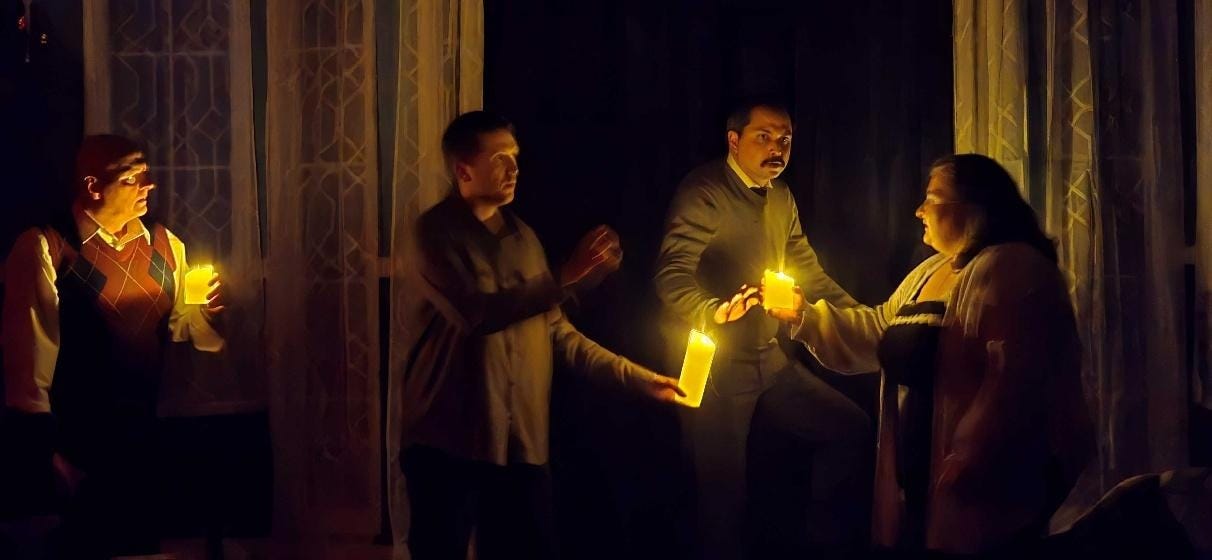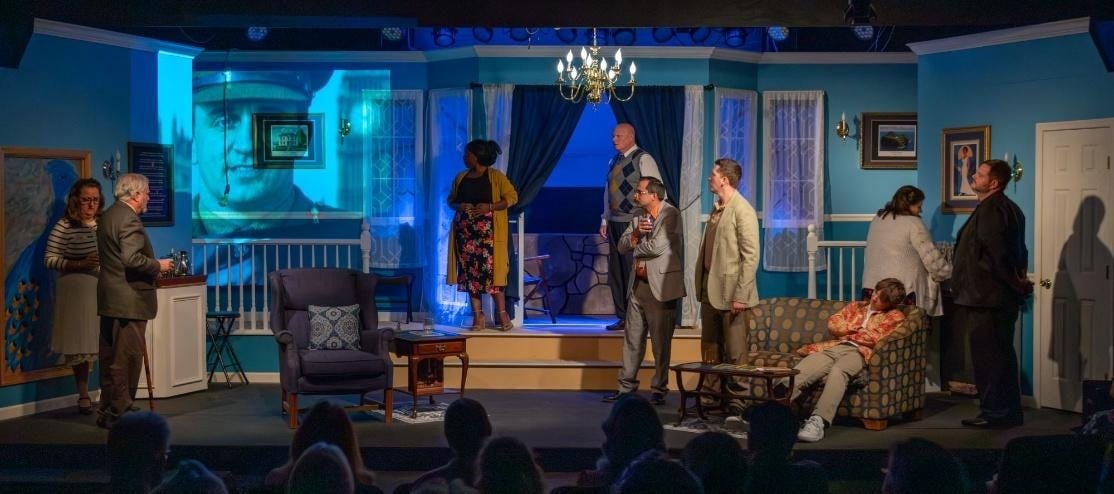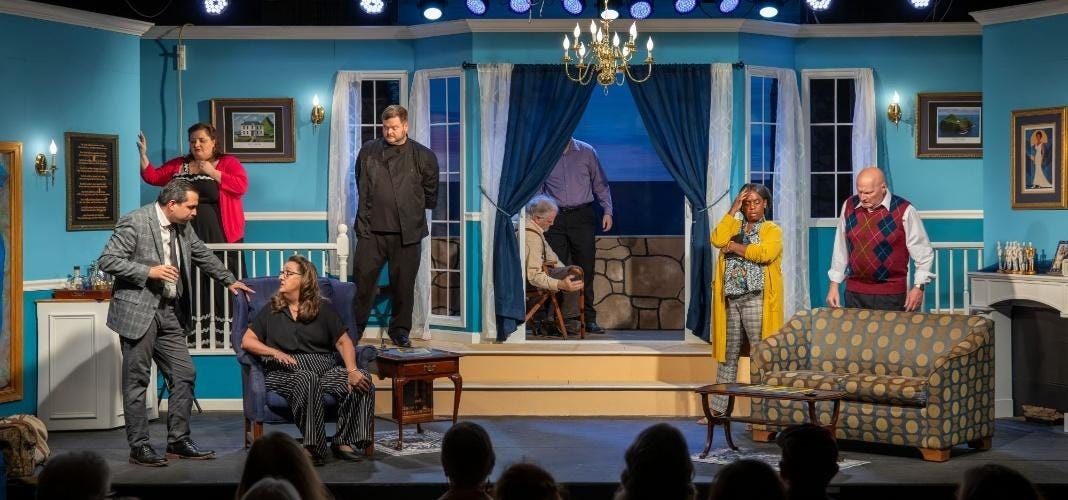THEATRE REVIEW - Another One Bites the Dust ...
Advance Theatre Critic Dennis Wemm takes in "And Then There Were None."
And Then There Were None
Directed by Benjamin Bryant, Technical direction by Tommy Zamberlan
Caroline Community Theatre
A play is a game that is shared by performers and audiences. The performers are guides that share and embody the story for us. The story might be familiar or not, it might play with our deepest emotions or allow us to examine the values and myths that hold the audience’s society together. The rules are fairly simple: one group makes itself listen and watch, gathering clues about the characters and the situation. They then experience complications as live action sharing the same physical space with us. A murder mystery makes the stakes of the game mortal.
The play itself concerns ten people (“ten little soldiers” in this version of the play) represented by dolls on the mantelpiece. Each person in the play is a possible killer, and each person is a possible victim. In a detective mystery, motive, means, and opportunity are proven by a seasoned detective or by a highly talented amateur. In this real-time, locked-room mystery, there’s no detective deposing the suspects to reveal a predetermined killer. Motives, in this play, are murky because the stories come out in first person: a series of conversations that are varied. No one is required to confess honestly, and everyone is worried about surviving the experience of being marooned on an island surrounded by murder suspects, each of whom is accused of murder or responsibility for someone’s death in the past by a mysterious voice on a phonograph record.
The question of whodunit becomes academic, the question of whether they’ll survive before they get to the mystery’s answer becomes paramount. It’s a race for survival, and, true to the title, none survive. No spoiler here!
Okay, so that’s the game. We have to be interested in the characters, even like them, while suspecting them of being the guilty party. Yes, even the butler could have dunnit. And every time one dies, one of the dolls on the mantelpiece breaks in the same manner.
Invited to a mansion on a lonely island are an odd assortment of potential killers and victims. It’s a long tradition of this kind of play that we meet the “downstairs” people first: Thomas and Ethel Rogers (Mike Cannon and Jenelle Cannon), chatting with a boatman/delivery man (Naracott, played by director Benjamin Bryant) who is ferrying the other characters to the island. They provide the background for the house, owned by a mysterious Mr. Owen (or Mrs. Owen?), whom we will hear but never meet.
The invitees arrive in small groups: Vera, a secretary who knows way too little about her employer (Kathleen Keller) arrives with Captain Lombard (Justin Yates). They proceed with the ritual of getting to know each other over drinks, reservedly flirting in a British sort of way.
Group by group the others arrive and are introduced: some are socially famous, well connected professionals: the aged General Mackenzie (Bruce Wiljanen), Dr. Armstrong (Rae Ehlen), and magistrate Dame Lydia Wargrave (Tanya Keys). They make their acquaintance with each other and each lets the others know their opinions of their companions. Others are less recognized: young and callow Anthony Marston (Lucas Baker), energetic and extremely impulsive, and William Blore (David Myers), a man with a secret identity.
Once all ten of the little soldiers are gathered together, the voice of Mr. Owens tells them why they were invited. In each case, they either knowingly, directly killed or placed in deadly danger a victim of their own. They are warned that they will not escape retribution.
And they immediately start to investigate who among them is likely to kill again. They pick apart each other’s foibles and character flaws, searching for the clue that will uncover the source of the danger.
And one by one, they begin to die in the manner described in a nursery rhyme, kind of like a more threatening adult version of “Ten Little Monkeys Jumping on a Bed.” Except that our ten have no way to avoid their danger: weather and Mr. Narracott’s missing boat forbids their escape.
That means that no, I’m going to spoil neither the means of each execution nor who the mysterious Mr. Owen is. Christie is playing very fair with her own rules.
The performances ring very true. The audience stayed in tune with the performers, looking for clues dug up or inadvertently revealed by the characters.
Visual storytelling is very striking. There are few moments where stage tricks seem unmotivated or when the audience gasping reactions seem unearned. One scene, due to a brownout followed by a blackout is particularly effective-we’re so conditioned by special effects that as the scene continues on conventionally tension builds as we wonder what will happen in the dark. Audience tension (and attention) was played like a violin. Everyone in the auditorium stayed with the game to the end.
Time seems to have caught up with some of the scenes. The actors remained true to their characters and their place in the story, but many of the moments that a more modern script would accomplish by a staging effect or an intensely played moment of silence are telegraphed by dialogue. Sometimes Christie seems to mistrust her audience’s ability to put two and two together. The actors seem to find the truth in each moment, and that brought them a standing ovation the night I saw the play.
Bryant’s direction is sure, and all of his strategies seem to pay off well. The play being updated by twenty-some years doesn’t affect our appreciation of it. It allows for a better connection with the style of music used (and composed) to underscore some scenes and to tie them together. The set is well-constructed and seamless, the room looks like it has stood as long as the dialogue indicates. Furnishings are necessarily spare but appropriate to an early 1960s environment. Kudos to Tommy Zamberlan and his crews for providing a fitting and interesting environment for the actions.
A couple of crotchets
One scene that does not take place on the main set is well staged on the floor in front of the stage. Problem: it’s really hard to see some of that action through the heads and bodies of the audience in front.
Another problem: the naturalness of the behaviors from the 1960s used in the show limits the vocal energy required for the 1940s dialogue. There’s a drive or momentum that the older speech patterns used that made “talky” scenes as engaging as action scenes. That was somewhat lost.
Due to a delay in my viewing of the show, this review cannot reach release before the final performance. I can only say that I believe you would have enjoyed the performance as much as I did.
TL/DR
Murder mysteries are a different kind of experience, a sub-genre of the theatre game. Agatha Christie’s mysteries are the work of a true professional writer with a wickedly sharp sense of humanity and a fascination with the game’s rules. The main rule, of course, was laid down by Sherlock Holmes in The Sign of the Four, “When you have eliminated all which is impossible, then whatever remains, however improbable, must be the truth.” If the playwright and production company play the game fairly, the audience’s attention is kept and everyone has a great time solving the case with each other’s help.
And Then There Were None is one of Christie’s most enduring works, the bestselling murder mystery ever. The author blends the serious side of the situation (people increasingly but plausibly trapped in a dangerous place in a dangerous time) with a set of characters (who are dangerous themselves) but just human enough that we connect with each one. Everyone is a potential murderer, everyone a potential victim.
While the story was written and published in 1939, the play adaptation (written by Christie) appeared in 1943 and has been adapted to different media under many different titles. Let’s also just say that it has been parodied in many different formats, including the wildly popular Clue franchise.
It is a script in the manner of mystery plays from the 1940’s. Where modern works rely on short clipped dialogue and built in broad humor for this kind of script, the earnest quality of And Then There Were None stands alone.
Dennis Wemm is a retired professor of theatre and communication, having taught and led both departments at Glenville State College for 34 years. In his off time, he was president and sometimes Executive Director of the West Virginia Theatre Conference, secretary and president of the Southeastern Theatre Conference, and generally enjoyed a life in theatre.
Local Obituaries
To view local obituaries or to send a note to family and loved ones, please visit the link that follows.
Support Award-winning, Locally Focused Journalism
The FXBG Advance cuts through the talking points to deliver both incisive and informative news about the issues, people, and organizations that daily affect your life. And we do it in a multi-partisan format that has no equal in this region. Over the past year, our reporting was:
First to break the story of Stafford Board of Supervisors dismissing a citizen library board member for “misconduct,” without informing the citizen or explaining what the person allegedly did wrong.
First to explain falling water levels in the Rappahannock Canal.
First to detail controversial traffic numbers submitted by Stafford staff on the Buc-ee’s project
Our media group also offers the most-extensive election coverage in the region and regular columnists like:
And our newsroom is led by the most-experienced and most-awarded journalists in the region — Adele Uphaus (Managing Editor and multiple VPA award-winner) and Martin Davis (Editor-in-Chief, 2022 Opinion Writer of the Year in Virginia and more than 25 years reporting from around the country and the world).
For just $8 a month, you can help support top-flight journalism that puts people over policies.
Your contributions 100% support our journalists.
Help us as we continue to grow!
This article is published under Creative Commons license CC BY-NC-ND. It can be distributed for noncommercial purposes and must include the following: “Published with permission by FXBG Advance.”
















